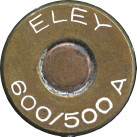

During the middle part of the Great War (1914 – 1918) the British required a weapon/cartridge system to combat two threat areas, namely aircraft machine guns and guns capable of taking on the Zeppelins and secondly – maybe more urgent – to combat the threat of observation balloons, even though it was also used by the British. For this purpose, they used .45-inch Maxim Guns fitted to aircraft, loaded with various types of tracer, incendiary and explosive bullets, with varying degrees of success. By 1918 however, it became clear that these Maxims were far from ideal. The .45-inch bullet at that stage was still considered the optimal caliber for black powder weapons, which was adopted by most European Nations during the 1870’s. It could be argued that the Gatling and the .45-inch was used, was because it was all that was available and there was nothing else.
It was during the latter part of 1917 that work began on developing a .50-cal. bullet that was able to carry a larger incendiary load than that of the .303 Air Service ammunition as well as the .45-inch bullets. The first of these designs was a 600 Nitro Express case that was lengthened and necked down to .50-cal and adopted for the Vickers Machine Gun. This cartridge was also considered for use in an anti-tank rifle. The advancements in tank armour after the war meant that it was only the air service that merited further development. During 1918 the case was redesigned into the belted case shown above. The ‘A’ on the headstamp is believed by Labbett:212 to indicate a case with the web reinforced, but still reports were received of cases separating so in 1921 the decision was made to change the design to a rimless cartridge. This cartridge became known as the .50 Vickers.
Source: Labbett P, British Small Arms Ammunition 1864 – 1938.
